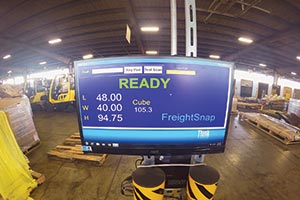LTL Carriers Boost Dimensioner Use to Improve Pricing Accuracy, Profits

This story appears in the April 4 print edition of Transport Topics.
Less-than-truckload carriers have more than quadrupled the use of dimensioner technology to improve pricing accuracy and profitability, experts said.
More than 200 of the scanning units are in place compared with fewer than 50 about three years ago, said Michael Scheid, senior analyst at SJ Consulting Group. Growth is most visible among the 15 largest carriers, which account for more than 90% of LTL revenue.
“The primary benefit from the scanners is more accurate dimensional data, which results in more accurate costing and better pricing decisions,” said Sean Healy, senior vice president at FedEx Freight, the largest LTL carrier. “The dimensional scanners pay for themselves in less than a year and are an important part of our yield improvement program.” Parent company FedEx Corp. ranks No. 2 on the Transport Topics Top 100 list of the largest U.S. and Canadian for-hire carriers.
FedEx Freight has 45 dimensioners in place and plans to add 38 by next May.
“Since the end of 2015, we have completed installation of the first dimensioners in our network,” said Paul Dugent, vice president of pricing at No. 15 Estes Express Lines, with 72 units. Estes’ initial target is to scan half of available freight on pallets.
Dugent and others emphasized the primary benefit of improved pricing.
Jamie Pierson, chief financial officer for No. 5 YRC Worldwide, said use is growing “because we want to get paid for the work and service we provide, and at the end of the day, outside of service, we sell space on a trailer, not just weight.”
YRC added dimensioners over the past two years and now has 70 of them. Pierson said more could be added, though they won’t ever be installed at every terminal.
UPS Freight, the LTL unit of No. 1 UPS Inc., plans to add dimensioners this year to the several in place, Vice President Bob Topel said. He also emphasized the value of more accurately pricing freight.
Woody Lovelace, senior vice president of corporate planning and development at No. 28 Southeastern Freight Lines, said the carrier plans a significant expansion of its dimensioner program in the second half of
this year. Southeastern has several units in use. The carrier is ready to expand dimensioner use now in the expectation that additional new technology is about to become available to supplement its well-developed weight and inspection program.
Saia Inc. uses 33 dimensioners, said Lloyd Rawson, director of weights and research. He said revenue for the company, No. 26 on the for-hire TT100, has been enhanced by using them but didn’t say by how much.
Pitt Ohio, No. 52, uses them at high-volume terminals, Chief Marketing Officer Geoff Muessig said.
“Access to more precise shipment density information has enabled
Pitt Ohio to further minimize the cross-subsidization of rates,” Muessig said, allowing the carrier’s pricing to be fairer overall to its customers.
Scheid said carriers typically run between 30% and 40% of their freight through their dimensioners.
“Generally speaking, the only shippers that do not want to move away from the incredibly outdated, antiquated and candidly archaic tariff format are those that generally try to take advantage of either misclassifying their freight or using a Freight All Kinds pricing scheme to game the National Motor Freight Classification standard,” said Pierson, who believes that rate system originated in “the mid-1950s when Dwight Eisenhower was president.”
The NMFC method assigns rates based on four characteristics: liability, stowability, handling and density.
Based on those characteristics, commodities are assigned to nearly 20 groups based on those characteristics that determine rates.
NMFC didn’t respond to requests for comment.
The wider presence of dimensioners has made it easier to price freight solely based on density, Scheid said. However, shippers have been slow to adopt that approach, he said, estimating that fewer than 5% of shippers use density-based pricing, in part because they don’t have the units at their facilities to determine the measurements.
Carriers haven’t pushed customers very hard to use density-based pricing, he said, because their shippers would have to use it as well.
“Carriers can’t make one sweeping change [in pricing]. There are thousands of pricing contracts and tariffs out there for their shippers,” Scheid said.
The percentage could grow, Dugent, Pierson and others said.
“We are seeing an increasing number of customer inquiries about density-based rates, and there is a strong possibility that this method of rating will be more acceptable in the future,” Estes’ Dugent explained.
“The LTL industry continues to see an increase in the number of density-based NMFC shipments, as well as an interest in a simplified pricing model that leverages shipment dimensions versus traditional classbased pricing,” FedEx said.
No. 14 XPO Logistics, No. 11 Old Dominion Freight Line and No. 12 ArcBest Corp.’s ABF Freight declined to comment about the use of dimensioners.

